Customer may be king in retail, but knowing your customer is key to staying rele
How can Cloud help retailers deliver better personalised customer experiences, with data driven decision techniques?


 “What doesn’t kill you makes you stronger."
“What doesn’t kill you makes you stronger."
That adage was particularly true for India’s retail sector. The nearly US$900 billion-worth industry was one of the most affected globally from the COVID-19 pandemic. Multiple lockdowns that cutoff walk-ins coupled with massive supply chain shortages threatened to kill an industry still making the transition to organised retail.
“The solutions for digital transformation were more or less (already) in existence," said Livspace’s Ramakant Sharma. “What has happened is the faster adoption of those solutions," the co-founder of Home interior and renovation platform added. “Because of this pandemic, most of us have been forced to really use those things which were available."
But having made the pivot to adopting the mass-market technology, it is time to centralise and collate that data by moving it into the cloud. That was a key learning from the panel of industry veterans speaking at the Retail Panel of the The Next Wave Of Cloud Innovation forum organised by Forbes India & Google Cloud.
“Retail is all about the details," said Accenture India’s Manish Gupta. “From supply chains to the shopping channel, everything now needs to be approached from the lens of timely, targeted, and tailored experiences for customers especially as digital-first shopping journeys are blurring the lines between the physical and digital brand experience," the managing director and India business head for Consumer Centric Industries added. “Shoppers want to know what’s available before they visit your stores, and they expect a variety of fulfillment options."
The pandemic cost the Indian retail sector an estimated US$30 billion in lost revenue. But it also sets it up for a strong bounceback a tech-first approach to emerge as the world’s most technologically savvy retail industry.
“One has to really leverage technology across the value chain...and not just a single-use case," said Sameer Dhingra, director for the retail and consumer verticals for the Japan and Asia Pacific regions at Google Cloud. The Alphabet Inc., company can not only help retailers modernize but also remove limits on product discovery and with customer personalization, he added.
“A lot of the stuff that my fellow panelists talked about (customer) personalisation or recommendations cannot be done unless you have a strong data foundation," Sameer pointed out. “And once you have that, then we can try to really leverage the Artificial Intelligence (AI) and Machine Learning (ML) models."
That is particularly true once one understands the enormity of the problem statement.
Building a kitchen alone requires working with no less than 120 stock-keeping units (SKUs) across the trade, appliances and other vendors, Livspace’s Sharma pointed out. That problem has been particularly accentuated with the lack of migrant labor that has returned to the villages of India.
“Improving operational efficiencies becomes extremely important," said Sameer from Google Cloud. “We also work with our customers to see how we can really reduce costs, reduce stress, and ensure that they are not only operationally efficient but also able to reach their customers either through messages or the contact center," he added.
This comes as the modern storefront and the traditional Indian “kirana" shop itself undergoes a transformation. Indian retail is already at the cusp of a technological revolution thanks to the government-backed Unified Payments Interface (UPI) that has upended the traditional Point-of-Sale (POS) infrastructure that retailers relied on globally. Google’s toolkit for retailers in the form of Google Pay, book-keeping on the cloud, invoice generation for SMEs as well as store-front location and websites on Google Maps and “India Get Your Business Online" program already places the Mountain View, CA-based tech giant in good stead with Indian retailers.
Last but not the least, Indian retail’s more than a century-old mantra of “Atithi devo bhava" will hold it in good stead for the next 100 years.
“First obsess about customer needs, and then use that as a compass," opined Accenture’s Gupta. “If you look at the examples such as Livspace, there were unmet customer needs that these companies addressed," he added.
With Indian consumers spoilt for choice, surviving and thriving in this environment needs ensuring a customer has a great experience in the entire journey from the farm-to-table, the panelists agree.
“And all that is underpinned with the sync between tech and data," Accenture’s Gupta said. “If all those things work seamlessly, I think the organisation will succeed."
Never letting a customer go empty handed by trying to stock everyday needs was always a mantra for Indian retail, it may now be an opportune time to do that with customer data, on the cloud.
The pages slugged ‘Brand Connect’ are equivalent to advertisements and are not written and produced by Forbes India journalists.
First Published: Dec 10, 2021, 15:52
Subscribe Now